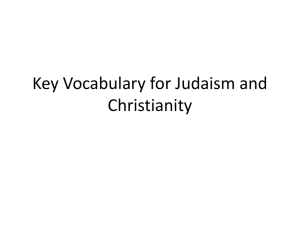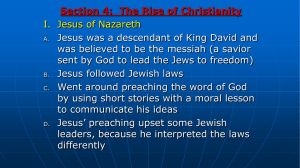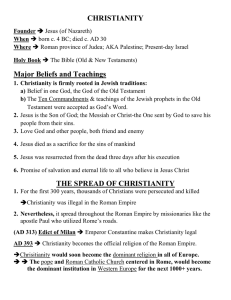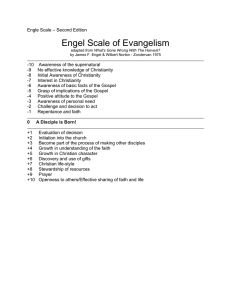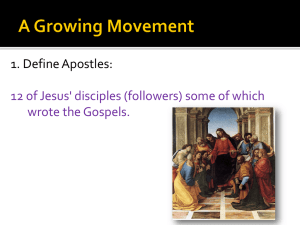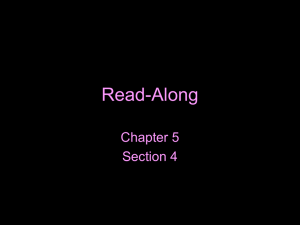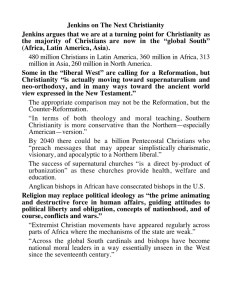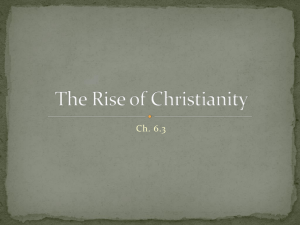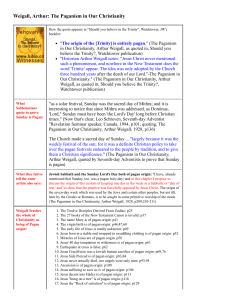Chapter 8 homework (1).doc
advertisement
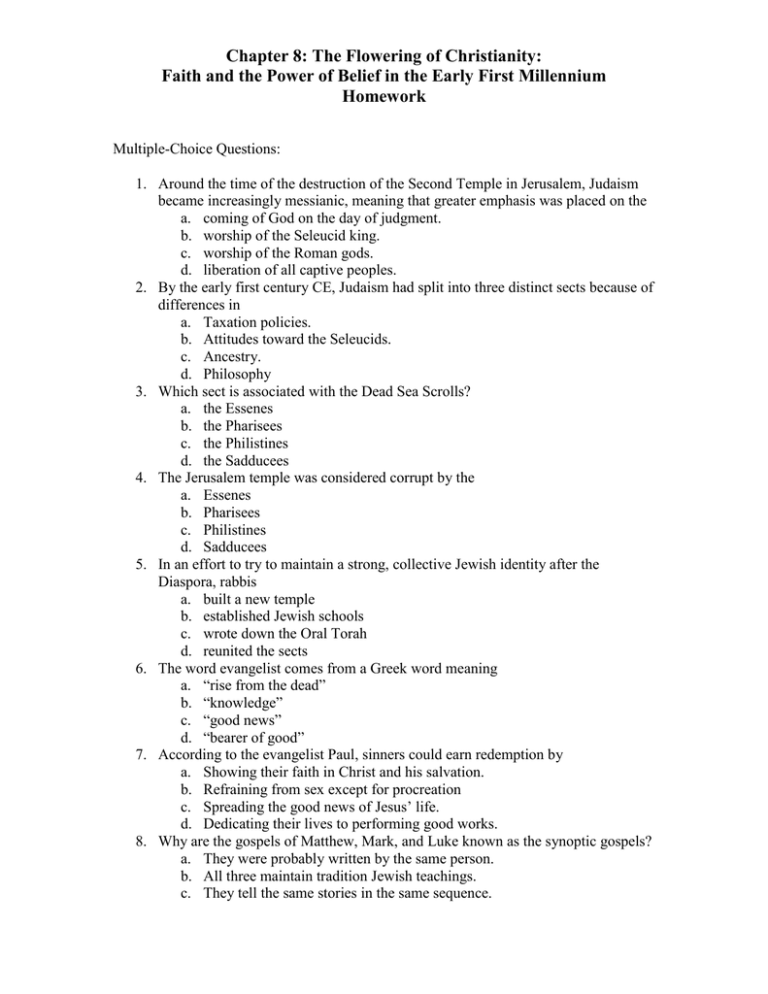
Chapter 8: The Flowering of Christianity: Faith and the Power of Belief in the Early First Millennium Homework Multiple-Choice Questions: 1. Around the time of the destruction of the Second Temple in Jerusalem, Judaism became increasingly messianic, meaning that greater emphasis was placed on the a. coming of God on the day of judgment. b. worship of the Seleucid king. c. worship of the Roman gods. d. liberation of all captive peoples. 2. By the early first century CE, Judaism had split into three distinct sects because of differences in a. Taxation policies. b. Attitudes toward the Seleucids. c. Ancestry. d. Philosophy 3. Which sect is associated with the Dead Sea Scrolls? a. the Essenes b. the Pharisees c. the Philistines d. the Sadducees 4. The Jerusalem temple was considered corrupt by the a. Essenes b. Pharisees c. Philistines d. Sadducees 5. In an effort to try to maintain a strong, collective Jewish identity after the Diaspora, rabbis a. built a new temple b. established Jewish schools c. wrote down the Oral Torah d. reunited the sects 6. The word evangelist comes from a Greek word meaning a. “rise from the dead” b. “knowledge” c. “good news” d. “bearer of good” 7. According to the evangelist Paul, sinners could earn redemption by a. Showing their faith in Christ and his salvation. b. Refraining from sex except for procreation c. Spreading the good news of Jesus’ life. d. Dedicating their lives to performing good works. 8. Why are the gospels of Matthew, Mark, and Luke known as the synoptic gospels? a. They were probably written by the same person. b. All three maintain tradition Jewish teachings. c. They tell the same stories in the same sequence. Chapter 8: The Flowering of Christianity: Faith and the Power of Belief in the Early First Millennium Homework d. Each tells of a different age of Jesus’ life. 9. Typology primarily helped Christians come to terms with their Jewish roots by a. Showing Jesus’ ethnic lineage to trace back to figures in the Hebrew Bible. b. Demonstrating the Hebrew Scriptures to be pre-figurations of Jesus’ life. c. Modifying the Hebrew stories to fit with Jesus’ teachings. d. Re-introducing certain key Jewish rituals such as circumcision. 10. Early Christians developed symbols to identify themselves to each other because they a. Were an illiterate people. b. Considered images to be sinful. c. Rejected the Latin alphabet. d. Feared persecution for their faith. 11. In Christian iconography, the evangelist John is symbolized by a. A winged man. b. An ox. c. A lion. d. An eagle. 12. The Roman emperor Constantine actively supported Christianity in Constantinople by a. Tearing down the pagan temples. b. Declaring Christianity the city’s sole religion. c. Openly favoring Christians as officials. d. Persecuting pagans who refused to become Christian. 13. By the fourth century CE, naturalism was no longer an important aim of art because a. The Christians dislike naturalistic art. b. The symbolic function supplanted it. c. Constantine refused to fund most art. d. Beauty was considered a sin. 14. True to the basilica form, St. Peter’s contained all of the following EXCEPT a. An Apse b. A Narthex c. A Pendentive d. A Nave 15. Early Christianity was syncretistic, incorporating into itself pagan traditions in order to a. Deter potential converts from Judaism. b. Convert pagans by presenting Christianity in their terms. c. Prevent non-believers from converting to Christianity for political reasons. d. Prevent Christianity from being viewed as a secret cult. 16. The Christian practice of baptism, idea of sacrifice for the good of humanity, and Jesus’ traditional birth date all derive from the pagan cult of a. The Greek Bacchus. b. The Egyptian Isis. Chapter 8: The Flowering of Christianity: Faith and the Power of Belief in the Early First Millennium Homework c. The Phrygian Cybele. d. The Persian Mithras. 17. Augustine of Hippo’s Confessions is particularly noteworthy as a literary work because it is the first a. Western autobiography. b. Epistolary Novel c. Book to address sex. d. Allegorical work of literature. 18. According to Augustine, the singing of hymns and psalms in church was established to a. Give people a connection to the service. b. Prevent people from becoming bored or sad. c. Make sacred words more beautiful. d. Allow people to exercise their creativity. 19. The Byzantine emperor Justinian began construction of Hagia Sophia in 532 CE to a. Establish himself as superior to Constantine in building programs. b. Honor his wife, who had persuaded him not to abandon Constantinople. c. Divert attention from domestic turmoil stirred up by warring gangs. d. Pacify Constantinople’s Christians, who objected to the city’s pagan schools. 20. San Vitale is unique for its a. Plain exterior b. Inclusion of Mosaics c. Use of round arches d. Octagonal shape 21. The mosaicists working in San Vitale depicted their subjects in reverse perspective and in shallow space to a. Draw the viewer’s eye to one vanishing point. b. Reject earthly illusion for the sacred space of the image. c. Cause the objects that are further away to seem smaller. d. Make the objects seem to float in ethereal space. 22. In Boethius’s estimation the highest form of music was a. musica mundane b. musica humana c. a yet-unheard music that combined qualities of each of the three classes of music d. musica instrumentalis 23. Why did the Byzantine emperor Leo III inaugurate a program of iconoclasm? a. He believed that too much of the church’s resources were being spent on art. b. He argued that God, in the Ten Commandments, had prohibited images. c. He objected to images of Jesus and Mary being used on coins. d. He claimed that churchgoers were being distracted from worship by the art. Chapter 8: The Flowering of Christianity: Faith and the Power of Belief in the Early First Millennium Homework 24. The Second Golden Age in Roman and Christian art was brought about by the a. Rise of Islam. b. Fall of Rome. c. Death of Leo III. d. Rise of the Macedonians. 25. During this Second Golden Age, artists portrayed Christ as a. Vulnerable and human. b. Powerful and wise. c. Disproportionately large. d. A Shepherd.
